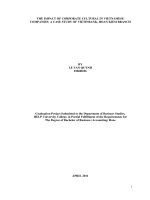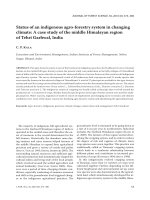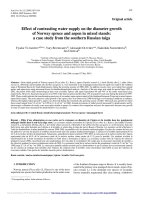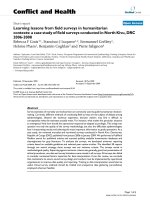the impact of corporate cultural in vietnamese companies a case study of vietinbank, hoan kiem branch
Bạn đang xem bản rút gọn của tài liệu. Xem và tải ngay bản đầy đủ của tài liệu tại đây (542.48 KB, 78 trang )
i
THE IMPACT OF CORPORATE CULTURAL IN VIETNAMESE
COMPANIES: A CASE STUDY OF VIETINBANK, HOAN KIEM BRANCH
BY
LE VAN QUYNH
E0600106
Graduation Project Submitted to the Department of Business Studies,
HELP University College, in Partial Fulfillment of the Requirements for
The Degree of Bachelor of Business (Accounting) Hons
APRIL 2011
ii
DECLERATION
I hereby declare that the graduation project is based on my original work except for
quotations and citations which have been duly acknowledged. I also declare that it
has not been previously or concurrently submitted for any other course/degree at
HELP University College or other institutions. The word count is 15,077 words.
_____________________
LE VAN QUYNH
Date:
iii
ACKNOWLEDGEMENT
This graduation thesis is the result of thirteen weeks of research and writing
during the spring of 2011. It has been an interesting and learning experience. In
fulfilling this thesis, I would like to give my special thanks to many people for their
significant help, contribution, and recommendations during my writing process.
First and foremost, special mentions and grate thanks must go to Ms. Dao Thi
Thu Giang, my supervisor at Hanoi Foreign Trade University. With her master
knowledge and experience in writing thesis, she has wholeheartedly helped me in
writing this thesis. I could not have been able to complete this thesis without her
positive suggestions and guidance.
Secondly, I want to thank all the managers and staffs of VietinBank, Hoan
Kiem Branch, for their cooperation that helped and inspired me in writing.
Thirdly, I would also like to give my heartfelt thanks to the authors who
provided me with valuable books for my thesis.
My appreciation is to my family and my friends for their supports and
encouragements.
Gratefulness is to the readers also, whose feedback will help much in
improving the thesis.
Hanoi, April 2011
Le Van Quynh
iv
THE IMPACT OF CORPORATE CULTURAL IN VIETNAMESE
COMPANIES: A CASE STUDY OF VIETINBANK, HOAN KIEM BRANCH
BY
LE VAN QUYNH
APRIL 2011
Supervisor: Ms. Dao Thi Thu Giang
Abstract
The graduation project represents the results of research on impact of
corporate culture in Vietnamese companies. The objectives of the project were to
understand impacts of corporate culture in Vietnamese companies which shows the
importance of corporate culture. Benefits of adopting corporate culture will create a
unique style and attitude for each company, creating centripetal force for the entire
company, helps companies boost innovation and invention, and attract more
customers.
In this thesis, the researcher uses case study of VietinBank, Hoan Kiem
Branch because this Branch may be given more accurate information and able to take
the right actions.
v
TABLE OF CONTENT
Page
DECLERATION ii
ACKNOWLEDGEMENT iii
Abstract iv
TABLE OF CONTENT v
LIST OF ABBREVIATION x
CHAPTER I - INTRODUCTION 1
1.1. Study background 1
1.2. The objectives of study 2
1.3. Research questions 2
1.4. Scope of research 3
1.5. Structure of the thesis 3
CHAPTER II - LITERATURE REVIEW 5
2.1. Overview 5
2.2. Definition of culture and corporate culture 5
2.2.1. Definition of culture 5
2.2.2. Definition of corporate culture 7
2.3. Corporate culture forming factors 9
2.3.1. Key business processes 9
2.3.2. Employees and other tangible assets 9
2.3.3. Formal arrangements 10
2.3.4. Dominant coalition 10
2.3.5. The social system 10
2.3.6. Technology 10
vi
2.3.7. The external environment 11
2.4. The impact of corporate culture on the development of a corporation 11
2.4.1. Creating the unique manner and attitude for each corporate 11
2.4.2. Creating the centripetal force for the whole company 12
2.4.3. Fostering innovation and invention 13
2.4.4. Creating the competitive advantage of the corporation 13
2.4.5. Attracting customers 14
2.5. Level of corporate culture 14
2.5.1. Observable artifacts 17
2.5.2. Espoused beliefs and values 18
2.5.3. Basic underlying assumptions 21
2.6. The role of leader – key factor creating the corporate culture of
organization 23
CHAPTER III - RESEARCH METHOLOGY 25
3.1. Overview 25
3.2. Research methodology 25
3.3. Data collection 26
3.4. Sampling 27
CHAPTER IV - RESEARCH ANALYSIS AND RECOMMENDATION 28
4.1. Overview 28
4.2. An overview of Vietinbank, Hoan Kiem Branch 28
4.2.1. Introduction of Vietinbank 28
4.2.2. Overview of Vietinbank, Hoan Kiem Branch 30
4.3. An overview of VietinBank’s corporate culture 32
vii
4.4. Levels and manifestations of corporate culture in VietinBank, Hoan Kiem
Branch. 33
4.4.1. Artifact level and its manifestations 34
4.4.1.1. Office’s architecture and decoration 34
4.4.1.2. Brand name, logo, and slogan 36
Source: VietinBank’s website, 2009 36
4.4.1.3. Language and style 38
4.4.1.4. Leadership Style 40
4.4.1.5. Behavior within the branch 41
4.4.1.6. Behavior toward customers 43
4.4.2. Espoused beliefs and values 44
4.4.3. The basic underlying assumption 48
4.5. Some suggestions to VietinBank in general 49
4.5.1. Identifying the right way of development 50
4.5.2. Improving the influence of core values inside and outside the whole system 52
4.6. Some suggestions to VietinBank, Hoan Kiem Branch 53
4.6.1. Leadership style as the decisive element in building and developing corporate
culture 53
4.6.2. Building the specific value system 55
4.6.3. Changing the physical working environment 57
4.6.4. Building up a close relationship between customers and branch 58
4.6.4.1. “Customer is King” 58
4.6.4.2. PR and face-to-face communication with customers 61
4.6.5. Learning from other organizations 62
CHAPTER V – CONCLUSION 64
viii
5.1. Conclusion 64
5.2. Limitation of research 65
REFERENCES 66
ix
LIST OF FIGURES AND IMAGES
Figures Title Page
Chapter 2
Figure 2.1. Maslow’s hierarchy of needs 13
Figure 2.2. Levels of corporate culture 15
Figure 2.3. Corporate culture – iceberg’s principle 16
Chapter 4
Figure 4.1. Organizational structure of VietinBank, Hoan Kiem Branch 31
Figure 4.2. VietinBank’s logo 37
Image 4.1. “Customer is King” 59
____________________________________________________________________
x
LIST OF ABBREVIATION
Abbreviation Full name
VietinBank Vietnam Joint Stock Commercial Bank for
Industry and Trade
Vietin Bank, Hoan Kiem Branch Vietnam Joint Stock Commercial Bank for
Industry and Trade, Hoan Kiem Branch
I.L.O. International Labor Organization
I.T. Information Technology
––––––––––––––––––––––––––––––––––––––––––––––––––––––––––––––––––––
1
CHAPTER I - INTRODUCTION
1.1. Study background
Recently, “corporate culture” has not been a new expression with
organizations and public. Many companies have not been afraid of investing in many
resources to form and develop their own culture. “Make a difference” is a philosophy
in business to improve the image of an organization under the eyes of society,
community and clients. One of the factors making the difference is the culture values
which are shaped, developed, recognized and popularized in many years. However,
not all organizations can be aware of the concept and connotation of the culture they
have.
Although corporate culture now is a popular term, there are many ways of
understanding leading to different definitions of corporate culture. In general,
corporate culture can be understood as all the culture values of an organization which
are formed during its development period. It has great influence on all activities of a
company as well as its workers. In fact, nowadays, corporate culture is one of the
important elements that many job hunters concern when they enquire about a
company. Besides, a good business environment can become an effective tool to
keep those current employees loyal to and dedicated to their organization.
Banking is an industry whose success is based on the belief of the clients.
Hence, forming a unique corporate culture which can make good impression on
customers is of greater importance for banks in general and for commercial banks in
particular. Vietnam Joins Stock Commercial Bank for Industry and Trade –
VietinBank is one of the top banks in Vietnam. Nowadays, corporate culture is one
of the greatest concern by both the leaders and officers of this bank. Therefore, I
2
chose the topic “The impact of Corporate culture in Vietnamese companies: A Case
Study of VietinBank, Hoan Kiem Branch” as graduation thesis topic in the hope that
some findings and recommendations from the study could be a reference to help
further developing a successful corporate culture for the branch.
1.2. The objectives of study
The study focuses on the concepts of corporate culture, the way it manifests
in an organization. From the findings withdrawn from the case study of a selected
organization – VietinBank, Hoan Kiem Branch, it is expected good
recommendations will be made for creating corporate culture process of this branch.
Thus, the study aims to:
i. Get deeper understanding of the corporate culture;
ii. Understand why, what and how an organization forms and develops
its corporate culture – a case study of VietinBank, Hoan Kiem
Branch;
iii. Find out some solutions and recommendations to develop and
improve the corporate culture in this branch.
1.3. Research questions
The key question of the study is: “What is the corporate culture of
VietinBank, Hoan Kiem Branch?” To answer this research question, it is necessary
to answer the following sub questions:
i. What is corporate culture?
3
ii. What are the manifestations of corporate culture in VietinBank, Hoan
Kiem Branch?
iii. What should VietinBank, Hoan Kiem Branch do to improve its
corporate culture in the future?
1.4. Scope of research
This study focuses on the corporate culture of VietinBank, Hoan Kiem
Branch, particularly, the way corporate culture manifests in this branch.
The study analyzes the corporate culture developed by the organization and
gives some recommendations for the organization to improve its culture to make its
difference in the eyes of society, community and clients.
1.5. Structure of the thesis
The thesis includes three five chapters:
Chapter 1: Introduction.
It identifies the statement of aims and objectives with clear indication of the issues,
problems and hypothesis being considered.
Chapter 2: Literature review.
Definitions, forming factors and impacts of corporate culture can be found in this
chapter. A description of the layers of corporate culture is also provided to help the
readers get a sound understanding of corporate culture.
Chapter 3: Methodology.
4
This chapter presents the research methods as well as data collections. The
manifestations are seen from different perspectives, ranging from visible to invisible
manifestations.
Chapter 4: Analysis and recommendation.
Firstly, the corporate culture in VietinBank, Hoan Kiem Branch will be
analyzed. The manifestations are seen from different perspectives, ranging from
visible to invisible manifestations. Next, recommendations are made to further
develop corporate culture in VietinBank, Hoan Kiem Branch. In that, this chapter
gives some suggestions for VietinBank in general to develop its culture. Then, based
on that, recommendations to further develop corporate culture in VietinBank, Hoan
Kiem Branch will be given.
Chapter 5: Conclusion.
The conclusion should be a brief resume of the investigation design and results and
an overall, personal evaluation of the whole study.
5
CHAPTER II - LITERATURE REVIEW
2.1. Overview
This chapter provides background knowledge about the study. The chapter
will be divided into five main parts: the common concepts of the study including the
concepts of culture and corporate culture; the forming factors and the main impacts
of corporate culture; the corporate culture’s levels developed by Edgar H.Schein and
a brief view on the role of leader to the development of culture in an organization.
2.2. Definition of culture and corporate culture
2.2.1. Definition of culture
Culture is a familiar expression with human being. Culture connects closely
with our lives, or in other word, culture was born at the same time with human
society. However, it was not until the seventeenth century, especially from the
second half of the nineteenth century, did scientists in the world concentrate on
conducting in-depth researcher in this field. Culture itself is a complex and
diversified issue. Therefore, each researcher has his own way to define what culture
is.
The word “culture” has many different meanings. For some, it refers to an
appreciation of good literature, music, art, and food. For a biologist, it is likely to be
a colony of bacteria or other microorganisms growing in a nutrient medium in a
laboratory Petri dish. However, for anthropologists and other behavioral
scientists, culture is the full range of learned human behavior patterns. The term
was first used in this way by the pioneer English Anthropologist Edward B. Tylor in
6
his book, Primitive Culture, published in 1871. Tylor said that culture is "that
complex whole which includes knowledge, belief, art, law, morals, custom, and any
other capabilities and habits acquired by man as a member of society." This
definition refers quite briefly to every aspect of spiritual culture but does not exhaust
the many uses of material culture which play a vital role in human culture treasure.
There came many other definitions of culture after Tylor. Nowadays, the
definition stated by Mr. Frederico Mayor, General Manager of UNESCO is agreed
by many people. To him, culture is defined as “the set of distinctive spiritual,
material, intellectual and emotional features of society or a social group, and that it
encompasses, in addition to art and literature, lifestyles, ways of living together,
values systems, traditions and beliefs” (UNESCO, 2002). This definition was
worldwide accepted at Intergovernmental Conference of culture policies in 1970 in
Venice. In 1982, this approach was admitted at the second conference named
Mondiacult.
In terms of economy, scientists have different approach to culture. In the
book of Geert Hofstede named Communication between Culture (1984), culture was
understood as the collective programming of the mind which distinguishes the
members of one category of people from another. In another viewpoint, according to
Rao and Swaminathan (1995) culture refers to the values and beliefs shared by
members in a society, includes patterns of behaving, feeling and reacting, and the
premises underlying behaviors.
From these above definitions, culture is summed up, spread and shared from
one generation to another. Culture is transmitted not only from parents to children
but also between social organizations, culture group, and from governments to
7
schools, churches and so on. Common thoughts and behaviors are generated and
maintained by social pressure and social trends. In this thesis, the author will use the
definition taken from the book International Business, 6
th
edition of Czinkota, 2001.
In this book, culture is defined as a system of typical behaviors of each individual in
every society. This system consists of every aspect from the way people think, talk,
and act to their habits, languages, material as well as spiritual products and their
common viewpoints.
Culture itself, which is both conservative and changeable, is a highly complex
portrait of people. Having a united definition of culture in mind will help us find an
easier way to approach the issue of corporate culture.
2.2.2. Definition of corporate culture
In the past, the answer for the question “Why do people work for a certain
company instead of one another?” might be the reasonable salary, the benefits or the
high position this organization offers. However, in today’s changing business
environment, intangibilities are increasingly more crucial to employees. One tangible
that seems to be most influential is corporate culture. So what is corporate culture? In
the early seventies of the twentieth century, following the spectacular success of
many Japanese corporations, American corporations started to pay attention to the
underlying reason behind it. The term of “corporate/organizational culture” was used
by organization research professors and managers to refer to one of the main reasons
behind Japanese corporations’ worldwide success.
Many in-depth researches on composing parts as well as huge impact of
corporate culture on the development of one enterprise were started to be carried out
8
at the beginning of the nineteenth decade. There are various definitions for the
concepts of “corporate culture”.
Louis Handy mentioned corporate culture in the book “Understanding
organizations” as set of understandings or meanings shared by a group of people that
are largely tacit among members and are clearly relevant and distinctive to the
particular group which are also passed on to new members.
According to Donnelly et al. (1992) organizational culture refers to the
impact on the environment resulting from group norms, values, philosophy, and
informal activities. What this definition implies is that corporate culture is similar to
culture in society as it has norms, values, beliefs and patterns of behavior. The
definition also highlights that values and norms create culture.
Another definition comes from the International Labor Organization-I.L.O in
2005 that “Corporate culture is the values, beliefs, norms, and traditions within an
organization that influence the behavior of its members”.
Nevertheless, the most general definition of corporate culture is given by a
professor of organization research, “Corporate culture is a pattern of shared basic
assumptions that the group learned as it solved its problems of external adaptation
and internal integration, that has worked well enough to be considered valid and,
therefore, to be taught to new members as the correct ways you perceive, think, and
feel in relation to those problems” (Edgar H.Schein, 2004).
This thesis will take this definition as the standard definition of the study.
9
2.3. Corporate culture forming factors
Although each enterprise’s special blend of elements develop a unique
culture, a comparison of many enterprises identifies seven culture shaping factors
(Plunkett and Attner, 1994). Each of these factors is in itself a complicated concept
and none is independent of the others. Their dynamic interaction forms the corporate
culture.
2.3.1. Key business processes
At the core of every corporation is the processes employees follow to gather
information, make decisions, communicate, produce a product or service and manage
work flow. The corporation is defined by how leaders communicate to employees,
how they share decision making and how they structure the work flow. The corporate
processes influence and are influenced by the other six factors that affect corporate
culture.
2.3.2. Employees and other tangible assets
A corporation’s resources such as employee population, plants and offices,
equipment, tools, land, inventory and money, are used by the corporation to carry out
its activities. These are the most visible and complex factors that influence culture
because their quality and quantity determine much of the corporation’s culture and
performance.
10
2.3.3. Formal arrangements
Another factor that affects corporate culture is the formal arrangements that
organize tasks and individuals. These arrangements include the structure of the
enterprise and its procedures, rules and specific mandated behaviors.
2.3.4. Dominant coalition
A corporation’s culture is significantly affected by the goals, objectives,
strategies, personal characteristics and interrelationships of its leaders, who form the
dominant coalition. The leadership style of the corporation leaders determines how
employees are treated and how they feel about themselves and their work.
2.3.5. The social system
The social system contributes norms and values to the corporate culture.
Components like employees relationships, the grapevine and the informal
organization are also parts of the social system. Because people are in the enterprise,
their relationships define the enterprise’s character.
2.3.6. Technology
The principle technological processes and equipment that employees use also
affect corporate culture. For example, the utilization of technology plays a role. The
question to ask regarding technology is: Is a machine or process intended to
productivity? The answer to this question sends a message about the value of
employees in the enterprise.
11
2.3.7. The external environment
An enterprise’s external environment includes forces outside its boundaries
that directly and indirectly interact with it (Bittel, 1989). These forces might be
suppliers, markets, competitors, regulators, organized labor and other elements
outside an enterprise. These forces affect the goals, resources and processes of an
enterprise. Obviously these elements shape the enterprise’s culture in many ways.
For instance, the government regulations can have a profound effect on corporate
culture as they normally protect the enterprise from competition.
2.4. The impact of corporate culture on the development of a corporation
2.4.1. Creating the unique manner and attitude for each corporate
Corporate culture is contributed by many components and elements such as
business philosophy, customs, rites, habits, trains, or even the legend of the founder,
etc. All of these elements together contribute the style of an enterprise and help to
distinguish this with others. This style or manner and attitude plays the role like “air
and water”, having a huge effect on the daily operation of enterprises.
It is not difficult to recognize the manner and attitude of a successful
corporation. This style makes the strong impression on the outsiders and is the pride
of the corporation’s members. Let’s take an example of the Walt Disney House.
When entering this corporation, people can feel some very common values through
the uniform, some conversational language used by Walt Disney’s employees (such
as “a nice Mickey” means “You are doing well”), common behaviors (always smile
and polite with customers) and common feelings (very proud of doing for Walt
Disney).
12
2.4.2. Creating the centripetal force for the whole company
A good corporate culture helps company attracting the talent and
strengthening employees’ loyalty.
A person works not for money but for other needs. The system of needs of
human, according to Maslow, 1943, is a triangle including five kinds of needs in
ascending order: basic needs, safety needs, psychological needs, self – actualization
and peak experiences. These needs are objective different tones of each individual.
Those needs create forces which impulse people to do but are not necessarily to be
the ideals of their life.
From the model of A. Maslow, it can be seen that it is wrong if a company
thinks that only high salary can help to attract and keep talent. An employee will be
loyal and want to have a strong attachment to a company only when he/she has
interest in working, feels the nicely air and has the chance to assert himself. In a
quality corporate culture, all members have a clear awareness of their roles within
overall, they work for common objectives.
13
Figure 2.1 - Maslow’s hierarchy of needs
Common example Organizational example
Source: Duong Thi Lieu, 2008
2.4.3. Fostering innovation and invention
Within a strong corporate culture, the high self-reliance will be emerged.
Employees are encouraged to be apart and raise their own ideas. This encouragement
helps employees proving their own creative abilities, as a base for R&D process of a
company. On the other hand, the success of workers will create a diving force which
helps to stick them with company for a longer time.
2.4.4. Creating the competitive advantage of the corporation
The competitiveness of an enterprise can be adjusted in four aspects:
flexibility (the ability of satisfying different needs of customer), the quality of
goods/services (technological characteristic, reliability, industrial design, etc.), the
Achievemen
t
Statu
s
Friendship
Stability
Food
Working
Challenges
Title
Colleges
Allowance
Base wage
14
responsible speed in the market (the period of time from ordering to supplying, speed
of developing a new product, etc.), cost (lower than competitors).
Enterprises who want to gain these advantages have to get three important
resources: human resources, capital and technology. The human resources involve
directly adjusting, choosing and developing competitive advantages process of
enterprise. Hence, this resource has the key meaning to the ability of gaining these
advantages. Meanwhile, corporate culture has the first direct effect on each member
of an enterprise, which plays an important role in proving human resource. So,
indirectly, corporate culture can affect the competitive advantages of an enterprise in
the market.
2.4.5. Attracting customers
Thanks to the manifestation of corporate culture in each level, corporate
culture helps to create the unique organizational character. This also helps to improve
the good image of company with customers, helps customers distinguish each
company and establishes the customers’ loyal with company’s goods and services.
2.5. Level of corporate culture
In general, corporate culture can be divided into two layers: surface layer and
core layer. Surface layer includes such expressions as dress code, work environment,
benefits, conversation, relationship, etc. The core layer consists of something cannot
see or hear like values, invisible rules, attitude, benefit, assumptions, etc. However,
according to Edgar H.Schein, a professor of organization research, in the book
“Organizational culture and leadership”, corporate culture has three layers or three
15
levels. They are observable artifacts, espoused values and basic underlying
assumptions.
Figure 2.2 - Levels of Corporate Culture
Source: Edgar H.Schein, 2004
If we regard corporate culture concept as a metaphor, three levels of
corporate culture can be described as an iceberg.
Artifacts
Visible organizational structures and processes (hard
to decipher)
Espoused Values
Strategies, goals, philosophies (espoused justifications)
Basic underlying assumptions
Unconscious, taken-for-granted beliefs, perceptions,
thoughts, and feeling (ultimate source of values and
action)









